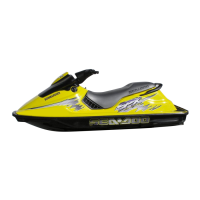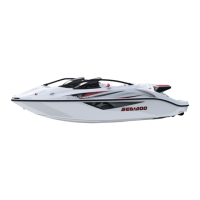SAFETY INFORMATION 29
TTRRAAIILLEERRIINNGG IINNFFOORRMMAATTIIOONN
NNOOTTIICCEE
TThhee ssppaann ooff tthhee ttrraaiilleerr bbuunnkkss iinn--
cclluuddiinngg bbuunnkk wwiiddtthh sshhoouulldd bbee aadd--
jjuusstteedd ttoo pprroovviiddee ssuuppppoorrtt
tthhrroouugghhoouutt tthhee ffuullll lleennggtthh ooff tthhee
hhuullll.. TThhee eennddss ooff bbootthh ttrraaiilleerr
bbuunnkkss sshhoouulldd nnoott eexxcceeeedd tthhee
lleennggtthh ooff tthhee wwaatteerrccrraafftt..
Ensure the trailer wheels are posi-
tioned so that the center of gravity of
the watercraft is slightly ahead of the
wheels to properly support the weight
of the watercraft.
Carry the watercraft in its normal oper-
ating position.
Check the applicable laws and regula-
tions in your area concerning towing a
trailer, especially for the following
items:
– Brake system
– Tow vehicle weight
– Mirrors.
Respect tow vehicle maximum weight
capacity and the tongue weight ca-
pacity as recommended by the
manufacturer.
Tie the watercraft to both front and
rear (bow/stern) eyelets so that it is
firmly secured on the trailer. Use addi-
tional tie-downs if necessary.
Ensure fuel tank cap, front storage
compartment cover, glove box cover,
boarding platform and seat are prop-
erly latched.
Remove all cargo and equipment
attached.
Observe trailering safety precautions.
Do not route ropes or tie-downs over
the seat or attach them to the grab
handle to avoid these parts perma-
nently damaged. Wrap ropes or tie--
downs with rags or similar protectors
where they can come into contact with
the watercraft body.
A Sea-Doo cover can protect the
watercraft, particularly when driving
on dirt roads, to prevent dirt entry
through the air inlet openings.
When trailering 2 watercrafts, it may
be necessary to remove the inner
wakeboard rack, if equipped.
For more information, see the follow-
ing video: SEA-DOO HOW TO SER-
IES - PROPER WATERCRAFT
TRAILERING
hhttttppss::////wwwwww.. yyoouuttuubbee.. ccoomm//wwaattcchh??
vv==mmXXttHHWWIIddtt77yyII
Or, use the following QR code.
